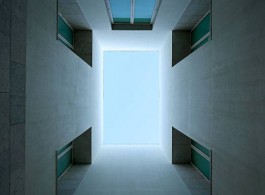Selling exhibition, featuring MAP Office, Jon Rafman, João Vasco Paiva, Tsang Tsou Choi, Adrian Wong, Chen Chien-jung, Gao Weigang, João Ó, & Jiang Zhi
MAP Office “Honeymoon Island”
A single oyster shell is encased within a transparent dome; on its surface, two minuscule plastic figures engaged in coitus appear to be enjoying their honeymoon under a miniature palm tree.
Jon Rafman “New Age Demanded: O’Keefe #4″
In this series, deformed 3D models of Greek busts combine with sci-fi elements and modernist paintings, evoking the covers to long lost “space operas.” Sci-fi is, for the artist, the literature of ideas, the world of alternative possibilities. The different pieces in the series can be seen to represent different individuals in different ages on different planets, imagined superheroes tied to moments in art history.
João Vasco Paiva “Map”
Having collected as source material the maps, diagrams, and signs that codify the flow of bodies through the Hong Kong rail system and emptied them of any representational or symbolic information, João Vasco Paiva translates the remaining images into process-based abstract paintings consisting of simple color fields that forefront a new set of codes through formal and aesthetic concerns. The pictured was originally a fare chart mapping various trip durations and directions.
Tsang Tsou Choi “Untitled (A22)”
Better known as the “King of Kowloon,” Tsang Tsou Choi passed away in 2007 after a lifetime of outsider aesthetic production. Believing that he was the rightful ruler of a portion of Hong Kong, he spent decades in conflict with the police and courts, insisting on writing out his genealogy and understanding of the world as calligraphic graffiti across the city in order to claim this urban space for himself and his family.
Adrian Wong “Transmission from Places Unknown”
A wall-mounted sound & light piece comprised of lighted prisms, each corresponding to a numerical code broadcast during the cold war over AM signal broadcasts. Largely considered to be “unbreakable,” many of these stations continue to transmit messages to this day. The resulting stream is similar in character to certain aphasias affecting individuals undergoing the delirium tremens – uttered with the conviction of everyday speech.
Chen Chien-jung “Landscape 65″
In his highly architectural paintings, muscular but faded works executed in a strong palette, the Chen Chien-jung constructs spaces between the visible and implied. Straight lines, partially erased and always somewhat obscured by rougher patches of material, constitute invisible spaces produced through the viewer’s desire for consummation. On the picture plane, these marks remain points of light in the undifferentiated conceptual darkness that insist on the treatment of the spatial as the key to any aesthetic narrative.
Gao Weigang “The Third Interior View”
Appearing as an interior depictions of some cold, institutional environment, the imagination of the viewer is left to fill in the gaps: these spaces could easily be drawn from color photographs of early computing centers or aeronautics control stations, but they might also and just as directly be considered as utopian diagrams for far future space stations yet to be constructed. The instability of the image referent transforms the canvas into an object, suggesting that the entire image has been dropped into this space from somewhere else.
João Ó “Thresholds: Skylight”
In this large-scale photography series, the João Ó collects singular visions of public spaces of passage across east Asia, consolidating a certain interpretation of an unpeopled urbanism perhaps endemic to the generic economic utopianism of the moment. Space is largely defined by the play of shape and line described by sources of light, while the environments seem to have been drawn from the set of a modern science fiction film.
Jiang Zhi “Selective Area: Secret No.2″
Jiang Zhi intentionally produces visual glitches through the manipulation of consumer software and a specially prepared graphics card, resulting in screen captures that resemble static patterns, repetitive neon bars, cascading windows, and other semi-digital if highly illegible formations. The artist then mediates these images again through another layer of negation, the painting process, in order to bring about a conceptual conflict between the transient moment and the historically monumental.
Nadim Abbas “I would prefer not to #17″
Abbas latches onto the opaque archetype of the “man without qualities,” a social role occupied by males lacking in the social graces who remain cut off from the world, immersed in the internet, videogames, and anime. Psychosexual imagery drawn from manga and otaku cultures is adopted to define anew the vocabulary of clinical psychology in a moment of ubiquitous mental dysfunction.
